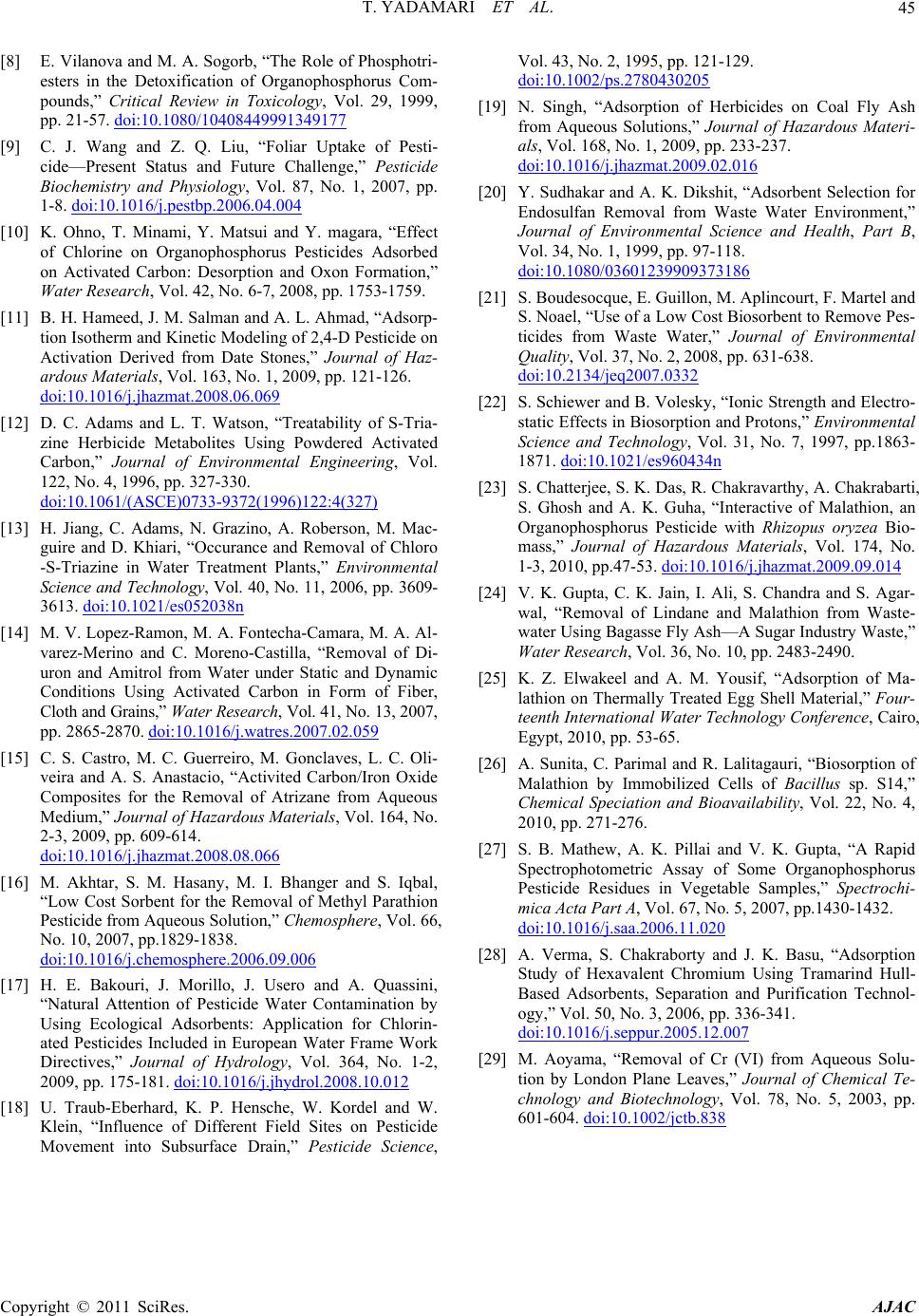
T. YADAMARI ET AL.45
[8] E. Vilanova and M. A. Sogorb, “The Role of Phosphotri-
esters in the Detoxification of Organophosphorus Com-
pounds,” Critical Review in Toxicology, Vol. 29, 1999,
pp. 21-57. doi:10.1080/10408449991349177
[9] C. J. Wang and Z. Q. Liu, “Foliar Uptake of Pesti-
cide—Present Status and Future Challenge,” Pesticide
Biochemistry and Physiology, Vol. 87, No. 1, 2007, pp.
1-8. doi:10.1016/j.pestbp.2006.04.004
[10] K. Ohno, T. Minami, Y. Matsui and Y. magara, “Effect
of Chlorine on Organophosphorus Pesticides Adsorbed
on Activated Carbon: Desorption and Oxon Formation,”
Water Research, Vol. 42, No. 6-7, 2008, pp. 1753-1759.
[11] B. H. Hameed, J. M. Salman and A. L. Ahmad, “Adsorp-
tion Isotherm and Kinetic Modeling of 2,4-D Pesticide on
Activation Derived from Date Stones,” Journal of Haz-
ardous Materials, Vol. 163, No. 1, 2009, pp. 121-126.
doi:10.1016/j.jhazmat.2008.06.069
[12] D. C. Adams and L. T. Watson, “Treatability of S-Tria-
zine Herbicide Metabolites Using Powdered Activated
Carbon,” Journal of Environmental Engineering, Vol.
122, No. 4, 1996, pp. 327-330.
doi:10.1061/(ASCE)0733-9372(1996)122:4(327)
[13] H. Jiang, C. Adams, N. Grazino, A. Roberson, M. Mac-
guire and D. Khiari, “Occurance and Removal of Chloro
-S-Triazine in Water Treatment Plants,” Environmental
Science and Technology, Vol. 40 , No. 11, 2006, pp. 3609-
3613. doi:10.1021/es052038n
[14] M. V. Lopez-Ramon, M. A. Fontecha-Camara, M. A. Al-
varez-Merino and C. Moreno-Castilla, “Removal of Di-
uron and Amitrol from Water under Static and Dynamic
Conditions Using Activated Carbon in Form of Fiber,
Cloth and Grains,” Water Researc h, Vol. 41, No. 13, 2007,
pp. 2865-2870. doi:10.1016/j.watres.2007.02.059
[15] C. S. Castro, M. C. Guerreiro, M. Gonclaves, L. C. Oli-
veira and A. S. Anastacio, “Activited Carbon/Iron Oxide
Composites for the Removal of Atrizane from Aqueous
Medium,” Journal of Hazardous Materials, Vol. 164, No.
2-3, 2009, pp. 609-614.
doi:10.1016/j.jhazmat.2008.08.066
[16] M. Akhtar, S. M. Hasany, M. I. Bhanger and S. Iqbal,
“Low Cost Sorbent for the Removal of Methyl Parathion
Pesticide from Aqueous Solution,” Chemosphere, Vol. 66,
No. 10, 2007, pp.1829-1838.
doi:10.1016/j.chemosphere.2006.09.006
[17] H. E. Bakouri, J. Morillo, J. Usero and A. Quassini,
“Natural Attention of Pesticide Water Contamination by
Using Ecological Adsorbents: Application for Chlorin-
ated Pesticides Included in European Water Frame Work
Directives,” Journal of Hydrology, Vol. 364, No. 1-2,
2009, pp. 175-181. doi:10.1016/j.jhydrol.2008.10.012
[18] U. Traub-Eberhard, K. P. Hensche, W. Kordel and W.
Klein, “Influence of Different Field Sites on Pesticide
Movement into Subsurface Drain,” Pesticide Science,
Vol. 43, No. 2, 1995, pp. 121-129.
doi:10.1002/ps.2780430205
[19] N. Singh, “Adsorption of Herbicides on Coal Fly Ash
from Aqueous Solutions,” Journal of Hazardous Materi-
als, Vol. 168, No. 1, 2009, pp. 233-237.
doi:10.1016/j.jhazmat.2009.02.016
[20] Y. Sudhakar and A. K. Dikshit, “Adsorbent Selection for
Endosulfan Removal from Waste Water Environment,”
Journal of Environmental Science and Health, Part B,
Vol. 34, No. 1, 1999, pp. 97-118.
doi:10.1080/03601239909373186
[21] S. Boudesocque, E. Guillon, M. Aplincourt, F. Martel and
S. Noael, “Use of a Low Cost Biosorbent to Remove Pes-
ticides from Waste Water,” Journal of Environmental
Quality, Vol. 37, No. 2, 2008, pp. 631-638.
doi:10.2134/jeq2007.0332
[22] S. Schiewer and B. Volesky, “Ionic Streng th and E lectro -
static Effects in Biosorption and Protons,” Environmental
Science and Technology, Vol. 31, No. 7, 1997, pp.1863-
1871. doi:10.1021/es960434n
[23] S. Chatterjee, S. K. Das, R. Chakravarthy, A. Chakrabarti,
S. Ghosh and A. K. Guha, “Interactive of Malathion, an
Organophosphorus Pesticide with Rhizopus oryzea Bio-
mass,” Journal of Hazardous Materials, Vol. 174, No.
1-3, 2010, pp.47-53. doi:10.1016/j.jhazmat.2009.09.014
[24] V. K. Gupta, C. K. Jain, I. Ali, S. Chandra and S. Agar-
wal, “Removal of Lindane and Malathion from Waste-
water Using Bagasse Fly Ash—A Sugar Industry Waste,”
Water Research, Vol. 36, No. 10, pp. 2483-2490.
[25] K. Z. Elwakeel and A. M. Yousif, “Adsorption of Ma-
lathion on Thermally Treated Egg Shell Material,” Four-
teenth International Water Technology Conference, Cairo,
Egypt, 2010, pp. 53-65.
[26] A. Sunita, C. Parimal and R. Lalitagauri, “Biosorption of
Malathion by Immobilized Cells of Bacillus sp. S14,”
Chemical Speciation and Bioavailability, Vol. 22, No. 4,
2010, pp. 271-276.
[27] S. B. Mathew, A. K. Pillai and V. K. Gupta, “A Rapid
Spectrophotometric Assay of Some Organophosphorus
Pesticide Residues in Vegetable Samples,” Spectrochi-
mica Acta Part A, Vol. 67, No. 5, 2007, pp.1430-1432.
doi:10.1016/j.saa.2006.11.020
[28] A. Verma, S. Chakraborty and J. K. Basu, “Adsorption
Study of Hexavalent Chromium Using Tramarind Hull-
Based Adsorbents, Separation and Purification Technol-
ogy,” Vol. 50, No. 3, 2006, pp. 336-341.
doi:10.1016/j.seppur.2005.12.007
[29] M. Aoyama, “Removal of Cr (VI) from Aqueous Solu-
tion by London Plane Leaves,” Journal of Chemical Te-
chnology and Biotechnology, Vol. 78, No. 5, 2003, pp.
601-604. doi:10.1002/jctb.838
Copyright © 2011 SciRes. AJAC